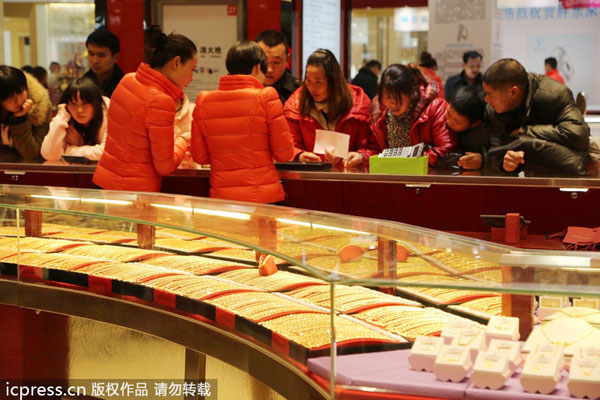 |
|
The freefall of gold price stirs Chinese consumers' spending spree on gold in 2013.[Photo/people.com.cn] |
The bargain-hunting middle-aged Chinese women known as "dama", have exerted the influence of the rising Chinese middle class in the gold market this year. As 2013 ends as a bleak year for gold, how do their gold investments look now?
Zhang Fengping, who along with her two sisters spent 100,000 yuan (about $16,500) on gold in May, says she is holding back to see what happens next.
"Gold prices plunged last week, encouraging me to buy another 100,000 yuan worth. But a relative who works in a bank suggested that I wait, because the price may continue to fall."
An analyst from?Societe Generale?is much more explicit: gold is losing ground as a safe-haven asset.
Throughout 2013, the global gold market has risen and fallen in line with expectations that the Federal Reserve would withdraw its quantitative easing (QE) stimulus. Gold has fallen 29 percent in 2013, and is heading for the biggest annual loss in 32 years.
Gold prices took off from $800 an ounce after the Fed started the first round of QE, known as QE1, in 2008, and then QE2 propped up the price to an all-time high of $1,920 an ounce in September of 2011. Worries about inflation in the US continued to impel investor demand for gold. Although the price fell to around $1,600, two months later it was soon pushed up to $1,800 by QE3.
Gold lost $200 an ounce in two trading days in April this year, a result of the recovering US economy and growing calls for scaling back QE.
|
 |
|
Consumers buy gold products in a gold store in Xuchang, Henan province, Dec 14, 2013. [Photo/icpress.cn] |
"The big fall in metal prices in 2013 is due to the prospect that the US may tighten its monetary policy, and especially when Bernanke said in May that the slowdown in QE may come soon, dragging gold down to $1,200 an ounce," says Sun Yonggang, an analyzer from Everbright Futures.
Gold traded on COMEX fell back again to $1,200 an ounce after the Fed said last week it would begin to taper its $85 billion in monthly bond purchases next month.
However, Chinese consumers are not deterred by the falling prices that have continued throughout this year. In the view of Liu Guangzhong, director responsible for the Far East area of the World Gold Council, Chinese consumer persistence is due to a traditional preference for gold as an investment.
"I admit that gold has been a bad investment choice this year. But I buy gold for my child, even for my grandchild, not for speculation. So I won't be affected too much by the rises and falls of the market," says Zhang Fengping.
Although Chinese gold consumers won't stop buying, they have to think about when it is the right time to take action. Market watchers believe they may wait for a long while.
"The US economy will continue a steady recovery that will draw more investors away from gold assets. If gold goes below $1,100, in other words, the average gold production cost, it will be a good time to increase holdings. This will likely happen in June or July next year," predicted Li Ning, analyst from Shanghai Cifco Futures.
Related readings:
China's Q3 gold consumption tops the world
Gold retains luster for Chinese consumers as economy improves
Gold rusher in golden time
